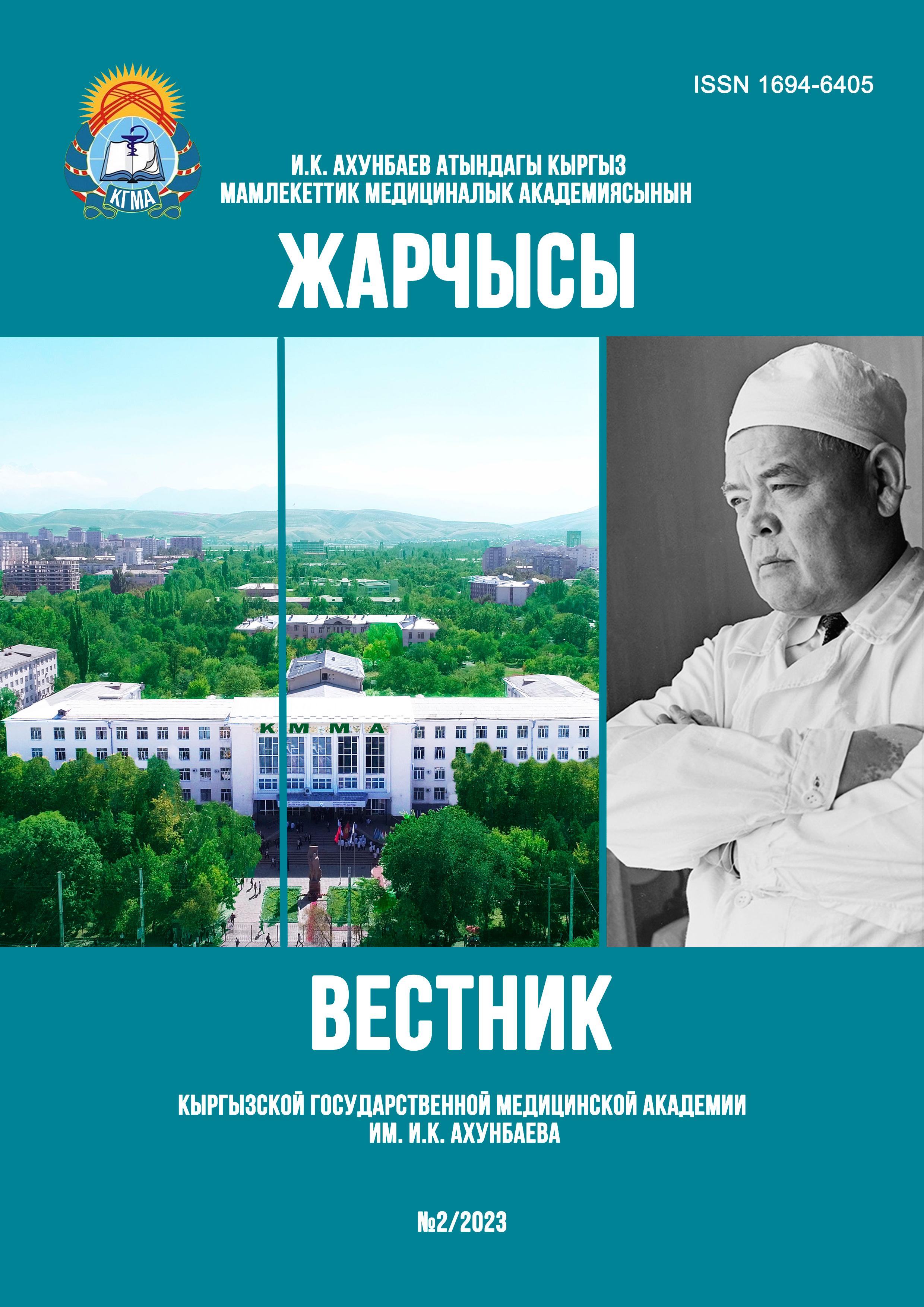PATHOGENESIS OF APLASTIC ANEMIA (LITERATURE REVIEW)
DOI:
https://doi.org/10.54890/1694-6405_2023_2_56Abstract
Aplastic anemia is a rare and life-threatening bone marrow insufficiency that leads to peripheral blood cytopenia and decreased proliferation of hematopoietic bone marrow cells. The symptoms are similar to myelofibrosis, myelodysplastic syndromes and acute myeloid leukemia, which makes it difficult to diagnose this disease. The pathogenesis of aplastic anemia is complex, and its mechanism needs to be deciphered on an individual basis. This review summarizes several contributions made in recent years in an attempt to understand the pathogenesis of aplastic anemia, which may be useful for the development of personalized treatments for this disease
Keywords:
aplastic anemia, definition, pathogenesis, hematopoietic stem cells, progenitor cells, immune dysfunction.References
1. Bär C, Povedano JM, Serrano R, Benitez-Buelga C, Popkes M, Formentini I et al. gene therapy rescues telomere length, bone marrow aplasia, and survival in mice with aplastic anemia. Blood. 2016;127(14):1770–1779. https://doi.org/10.1182/blood-2015-08-667485
2. Fan R, Wang W, Wang XQ, Lin GW. Incidence of adult acquired severe aplastic anemia was not increased in Shanghai, China. Ann Hematol. 2011;90(10):1239–1240. https://doi.org/10.1007/s00277-011-1168-5
3. Li SS, Hsu YT, Chang C, Lee SC, Yen CC, Cheng CN et al. Incidence and treatment outcome of aplastic anemia in Taiwan-real-world data from single-institute experience and a nationwide population-based database. Ann Hematol. 2019;98(1):29–39. https://doi.org/10.1007/s00277-018-3486-3
4. Садабаев Э.М., Мамажакып уулу Ч., Эралиева М.О., Джакпыбаев О.А., Маматов С.М. Эффективность иммуносупрессивной терапии при тяжелой форме апластической анемии. Вестник КРСУ. 2020; 20(5).70-74. [Sadabaev E.M., Mamazhakyp u. Chyngyzbek, Eralieva M.O., Dzhakypbaev O.A., Mamatov S.M. The effectiveness of immunosuppressive therapy in severe form of aplastic anemia. Vestnik KRSU.2020;20(5):70-74 (In Russ.)]
5. Akram Z, Ahmed P, Kajigaya S, Satti TM, Satti HS, Chaudhary QUN et al. Epidemiological, clinical and genetic characterization of aplastic anemia patients in Pakistan. Ann Hematol. 2019;98(1):301–312. https://doi.org/ 10.1007/S00277-018-3542-Z
6. Maciejewski JP, Selleri C, Sato T, Anderson S, Young NS. A severe and consistent deficit in marrow and circulating primitive hematopoietic cells (long-term culture-initiating cells) in acquired aplastic anemia. Blood. 1996;88(6):1983–1991.
7. Timeus F, Crescenzio N, Doria A, Foglia L, Linari A, Giacconeet M al. Flow cytometric evaluation of circulating CD34+ cell counts and apoptotic rate in children with acquired aplastic anemia and myelodysplasia. Exp Hematol. 2005;33(5):597–604. https://doi.org/10.1016/j.exphem.2005.02.005
8. Wu L, Mo W, Zhang Y, Deng H, Li Y, Zhouet R al. Impairment of hematopoietic stem cell niches in patients with aplastic anemia. Int J. Hematol. 2015;102(6):645–653. https://doi.org/10.1007/s12185-015-1881-2
9. Gao GF, Jakobsen BK. Molecular interactions of coreceptor CD8 and MHC class I: the molecular basis for functional coordination with the T-cell receptor. Immunol Today. 2000;21(12):630–636. https://doi.org/10.1016/s0167-5699(00)01750-3
10. Nakagawa MM, Rathinam CV. Constitutive activation of the canonical NF-kappaB pathway leads to bone marrow failure and induction of erythroid signature in hematopoietic stem cells. Cell Rep. 2018;25(8):P2094–2109.E4. https://doi.org/10.1016/j.celrep.2018.10.071
11. Young NS, Calado RT, Scheinberg P. Current concepts in the pathophysiology and treatment of aplastic anemia. Blood. 2006;108(8):2509–2519. https://doi.org/10.1182/blood-2006-03-010777
12. Young NS. Hematopoietic cell destruction by immune mechanismsn acquired aplastic anemia. Semin Hematol. 2000;37(8):3–14. https://doi.org/10.1182/blood-2006-03-010777
13. Locasciulli A, Oneto R, Bacigalupo A, Socié G, Korthof E, Bekassy A et al. Outcome of patients with acquired aplastic anemia given first line bone marrow transplantation or immunosuppressive treatment in the last decade: a report from the European group for blood and marrow transplantation (EBMT). Haematologica. 2007;92(1):11–18. https://doi.org/10.3324/ haematol.10075
14. Chuncharunee S, Wong R, Rojnuckarin P, Chang CS, Chang KM, Lu MY et al. Efficacy of rabbit antithymocyte globulin as first-line treatment of severe aplastic anemia: an Asian multicenter retrospective study. Int J Hematol. 2016;104(4):454–461. https://doi.org/10.1007/s12185-016-2053-8
15. Chen J, Desierto MJ, Feng X, Biancotto A, Young NS. Immune-mediated bone marrow failure in C57BL/6 mice. Exp Hematol. 2015;43(4):256–267. https://doi.org/10.1016/j.exphem.2014.12.006
16. Wilson A, Laurenti E, Oser G, Van der Wath RC, Blanco-Bose W, Jaworski M et al. Hematopoietic stem cells reversibly switch from dormancy to self-renewal during homeostasis and repair. Cell. 2008;135(6):1118–1129. https://doi.org/10.1016/j.cell.2008.10.048
17. Sertorio M, Du W, Amarachintha S, Wilson A, Pang Q. In vivo RNAi screen unveils PPARgamma as a regulator of hematopoietic stem cell homeostasis. Stem Cell Rep. 2017;8(5):1242–1255. https://doi.org/10.1016/j.stemcr.2017.03.008
18. de Bruin AM, Demirel O, Hooibrink B, Brandts CH, Nolte MA. Interferongamma impairs proliferation of hematopoietic stem cells in mice. Blood. 2013;121(18):3578–3585. https://doi.org/10.1182/blood-2012-05-432906
19. Gonzaga VF, Wenceslau CV, Lisboa GS, Frare EO, Kerkis I. Mesenchymal stem cell benefits observed in bone marrow failure and acquired aplastic anemia. Stem Cells Int. 2017;2017:8076529. https://doi.org/10.1155/2017/8076529
20. Maruyama H, Katagiri T, Kashiwase K, Shiina T, Sato-Otsubo A, Zaimoku Y et al. Clinical significance and origin of leukocytes that lack HLA-A allele expression in patients with acquired aplastic anemia. Exp Hematol. 2016;44(10):P931–939. https://doi.org/10.1016/j.exphem.2016.05.013
21. Gonzalez-Galarza FF, Takeshita LY, Santos EJ, Kempson F, Maia MHT, Soares da Silva AL et al. Allele frequency net 2015 update: new features for HLA epitopes, KIR and disease and HLA adverse drug reaction associations. Nucleic Acids Res. 2015; 43 (Database issue): D784–D788. https://doi.org/10.1093/nar/gku1166
22. Tichelli A, Schrezenmeier H, Socie G, Marsh J, Bacigalupo A, Dührsen U et al. A randomized controlled study in patients with newly diagnosed severe aplastic anemia receiving antithymocyte globulin (ATG), cyclosporine, with or without G-CSF: a study of the SAA working party of the European group for blood and marrow transplantation. Blood. 2011;117(17):4434–4441. https://doi.org/10.1182/blood-2010-08-304071
23. Yoshizato T, Dumitriu B, Hosokawa K, Makishima H, Yoshida K, Townsley D et al. Somatic mutations and clonal hematopoiesis in aplastic anemia. N Engl J Med. 2015;373(1):35–47. https://doi.org/10.1056/NEJMoa1414799
24. Liu C, Li Z, Sheng W, Fu R, Li L, Zhang T et al. Abnormalities of quantities and functions of natural killer cells in severe aplastic anemia. Immunol Invest. 2014;43(5):491–503. https://doi.org/10.3109/08820139.2014.888448
25. Sun W, Wu Z, Lin Z, Hollinger M, Chen J, Feng X et al. Macrophage TNF-alpha licenses donor T cells in murine bone marrow failure and can be implicated in human aplastic anemia. Blood. 2018; 132(26): 2730–2743. https://doi:10.1182/blood-2018-05-844928
26. Zaimoku Y, Takamatsu H, Hosomichi K, Ozawa T, Nakagawa N, Imi T et al. Identification of an HLA class I allele closely involved in the autoantigen presentation in acquired aplastic anemia. Blood. 2017;129(21):2908–2916. https://doi.org/10.1182/blood-2016-11-752378
27. Zeng Y, Katsanis E. The complex pathophysiology of acquired aplastic anaemia. Clin Exp Immunol. 2015;180(3):361–370. https://doi.org/10.1111/cei.12605







